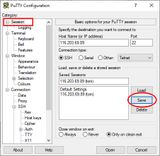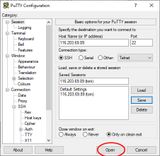Ändern der SSH Konfiguration
Die zuständige Konfigurationsdatei für den SSH Dienst ist /etc/ssh/sshd_config. Dort befinden sich eine Menge Konfigurationszeilen, die meisten jedoch sind nach einer frischen Linux Installation Auskommentiert. Das wird durch die Raute (#) am Anfang einer Zeile symbolisiert. Eine umfängliche Dokumentation über sshd_config gibt es auf der openbsd.org.
Wir öffnen die Datei mit sudo:
__$ sudo nano /etc/ssh/sshd_config
Uns interessieren an dieser Stelle nur folgende Zeilen:
Auszug aus /etc/ssh/sshd_config
...
#PubkeyAuthentication yes
...
#AuthorizedKeysFile .ssh/authorized_keys .ssh/authorized_keys2
...
Kommentieren wir #PubkeyAuthentication yes ein, indem wir das Kommentarsymbol (#) entfernen. Den Wert für AuthorizedKeysFile ändern wir zu %h/.ssh/authorized_keys. Die Variable %h steht für das home Verzeichnis des Benutzers. Wenn sich tom anmeldet, wird in seinem Benutzer Verzeichnis nach einem öffentlichen Schlüssel gesucht, um den eingereichten privaten Schlüssel zu verifizieren. In diesem Fall in der Datei /home/tom/.ssh/authorized_keys. Im letzten Kapitel haben wir hier bereits einen öffentlichen Schlüssel für tom hinterlegt.
Die gesamte /etc/ssh/sshd_config Datei sollte schließlich so aussehen:
/etc/ssh/sshd_config
# $OpenBSD: sshd_config,v 1.103 2018/04/09 20:41:22 tj Exp $
# This is the sshd server system-wide configuration file. See
# sshd_config(5) for more information.
# This sshd was compiled with PATH=/usr/bin:/bin:/usr/sbin:/sbin
# The strategy used for options in the default sshd_config shipped with
# OpenSSH is to specify options with their default value where
# possible, but leave them commented. Uncommented options override the
# default value.
Include /etc/ssh/sshd_config.d/*.conf
#Port 22
#AddressFamily any
#ListenAddress 0.0.0.0
#ListenAddress ::
#HostKey /etc/ssh/ssh_host_rsa_key
#HostKey /etc/ssh/ssh_host_ecdsa_key
#HostKey /etc/ssh/ssh_host_ed25519_key
# Ciphers and keying
#RekeyLimit default none
# Logging
#SyslogFacility AUTH
#LogLevel INFO
# Authentication:
#LoginGraceTime 2m
#PermitRootLogin prohibit-password
#StrictModes yes
#MaxAuthTries 6
#MaxSessions 10
PubkeyAuthentication yes
# Expect .ssh/authorized_keys2 to be disregarded by default in future.
AuthorizedKeysFile %h/.ssh/authorized_keys
#AuthorizedPrincipalsFile none
#AuthorizedKeysCommand none
#AuthorizedKeysCommandUser nobody
# For this to work you will also need host keys in /etc/ssh/ssh_known_hosts
#HostbasedAuthentication no
# Change to yes if you don't trust ~/.ssh/known_hosts for
# HostbasedAuthentication
#IgnoreUserKnownHosts no
# Don't read the user's ~/.rhosts and ~/.shosts files
#IgnoreRhosts yes
# To disable tunneled clear text passwords, change to no here!
#PasswordAuthentication yes
#PermitEmptyPasswords no
# Change to yes to enable challenge-response passwords (beware issues with
# some PAM modules and threads)
ChallengeResponseAuthentication no
# Kerberos options
#KerberosAuthentication no
#KerberosOrLocalPasswd yes
#KerberosTicketCleanup yes
#KerberosGetAFSToken no
# GSSAPI options
#GSSAPIAuthentication no
#GSSAPICleanupCredentials yes
#GSSAPIStrictAcceptorCheck yes
#GSSAPIKeyExchange no
# Set this to 'yes' to enable PAM authentication, account processing,
# and session processing. If this is enabled, PAM authentication will
# be allowed through the ChallengeResponseAuthentication and
# PasswordAuthentication. Depending on your PAM configuration,
# PAM authentication via ChallengeResponseAuthentication may bypass
# the setting of "PermitRootLogin without-password".
# If you just want the PAM account and session checks to run without
# PAM authentication, then enable this but set PasswordAuthentication
# and ChallengeResponseAuthentication to 'no'.
UsePAM yes
#AllowAgentForwarding yes
#AllowTcpForwarding yes
#GatewayPorts no
X11Forwarding yes
#X11DisplayOffset 10
#X11UseLocalhost yes
#PermitTTY yes
PrintMotd no
#PrintLastLog yes
#TCPKeepAlive yes
#PermitUserEnvironment no
#Compression delayed
#ClientAliveInterval 0
#ClientAliveCountMax 3
#UseDNS no
#PidFile /var/run/sshd.pid
#MaxStartups 10:30:100
#PermitTunnel no
#ChrootDirectory none
#VersionAddendum none
# no default banner path
#Banner none
# Allow client to pass locale environment variables
AcceptEnv LANG LC_*
# override default of no subsystems
Subsystem sftp /usr/lib/openssh/sftp-server
# Example of overriding settings on a per-user basis
#Match User anoncvs
# X11Forwarding no
# AllowTcpForwarding no
# PermitTTY no
# ForceCommand cvs server
Speichern wir die Datei noch ab (STRG+s, STRG+x) und starten den SSH Dienst neu, damit die Änderungen auch wirksam werden:
__$ sudo systemctl restart sshd
Damit ist die Anmeldung am Server auf zwei Arten möglich: Zum einen wie gehabt mit einem Benutzer Passwort und zum anderen mit dem privaten Schlüssel. Die erste Variante, also die reine passwortbasierte Anmeldung, werden wir im nächsten Kapitel abschalten. Bevor wir das tun, sollten wir zunächst testen, ob die neue Anmeldemethode auch funktioniert. Sonst laufen wir Gefahr, uns unwiderruflich auszusperren. Wir halten uns also die Möglichkeit offen, Konfigurationsfehler noch korrigieren zu können.
Melden wir uns zunächst ab, um den Test vollziehen zu können:
__$ logout
Je nach Betriebssystem oder Klienten variiert die Anmeldung mit Schlüssel. Nachfolgend die Beschreibung zu Windows, Mac und Linux.


